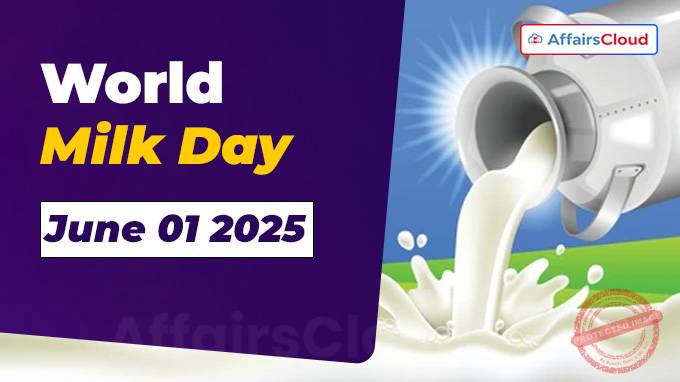 World Milk Day (WMD) is observed globally on June 1 every year to highlight the nutritional importance of milk, promote its consumption, and acknowledge the vital role of the dairy sector in supporting global nutrition, economic growth, and sustainability.
World Milk Day (WMD) is observed globally on June 1 every year to highlight the nutritional importance of milk, promote its consumption, and acknowledge the vital role of the dairy sector in supporting global nutrition, economic growth, and sustainability.
- The annual observance of the day was led by the Food and Agriculture Organization (FAO) of the United Nations (UN).
Theme:
The theme for WMD 2025 is “Let’s Celebrate the Power of Dairy,” underscores dairy’s multifaceted impact on health, livelihoods, and economies worldwide.
Background:
i.WMD was established in 2001 by FAO to promote milk’s benefits and celebrate the global dairy sector.
ii.The first WMD was observed on June 1, 2001.
Note: The date, June 1, was chosen as many countries celebrate National Milk Day around this time, facilitating a unified global observance.
Significance:
i.Milk provides essential nutrients like calcium, protein, and vitamins, which are crucial for healthy growth and development, especially in children.
ii.WMD not only promotes healthy dietary choices but also supports dairy farmers and emphasizes sustainable farming practices.
iii.The day promotes discussion on food security, supports rural livelihoods, and highlights the essential role of the dairy industry in nourishing and feeding the global population.
FAO’s Role and Global Observance:
i.Although not an official UN day, FAO’s Markets and Trade Division coordinates global celebrations via the Dairy Market Network, sharing information on dairy industry developments.
ii.Over 100 countries participate through events like farm visits, social media campaigns (#WorldMilkDay), and educational programs
Global Dairy Impact:
i.Global milk output reached 979 Million Tonnes (MT) (2024), growing at 1.4% annually.
ii.The top milk-producing countries globally in Financial Years 2023-24 (FY24) are: India with 239.2 MT, followed by the European Union (EU) with 149 MT, and the United States of America (USA) with 102.66 MT.
India’s Dairy Sector:
India has been the world’s largest milk producer since 1998, contributing 25% of global production. Key achievements:
i.Production Growth: Milk output rose 63.56% from 146.3 MT (2014-15) to 239.2 MT (2023-24), with a 6% Compound Annual Growth Rate (CAGR)
ii.Per Capita Availability: 471 grams/day (2023-24), surpassing the global average of 322 grams
iii.Economic Impact: Dairy contributes 5% to India’s economy and employs 8 crore (80 million) farmers directly
iv.Uttar Pradesh (UP) emerged as the top milk-producing state, accounting for 16.21% of India’s total milk output.
Schemes Driving India’s Dairy Revolution:
The Department of Animal Husbandry and Dairying (DAHD) under the Ministry of Fisheries, Animal Husbandry and Dairying (MoFAHD) implements key initiatives:
i.Rashtriya Gokul Mission (RGM): Launched in December 2014, RGM focuses on the development and conservation of indigenous bovine breeds. The revised mission, approved for the period 2021-22 to 2025-26, has an allocation of Rs 3,400 crore.
ii.National Programme for Dairy Development (NPDD): Initiated in February 2014 and restructured in July 2021, NPDD aims to enhance the quality of milk and increase the share of organized milk procurement.
- The revised program has a total budget of Rs 2,790 crore for the 15th Finance Commission cycle (2021-22 to 2025-26).
iii.Animal Husbandry Infrastructure Development Fund (AHIDF): Launched under the Atmanirbhar Bharat Abhiyan in June 2020, supports infrastructure for dairy processing, feed plants, and breed improvement.
- The scheme has been extended until 2025-26 with an outlay of Rs 29,610.25 crore.
iv.Livestock Health & Disease Control Programme (LHDCP): In March 2025, the Cabinet approved the revised version of the LHDCP.The scheme comprises three key components: the National Animal Disease Control Programme (NADCP), Livestock Health and Disease Control (LH&DC), and Pashu Aushadhi. The total outlay for two years (2024-25 and 2025-26) is Rs 3,880 crore.
v.Kisan Credit Cards (KCC): Since 2019, the Kisan Credit Card (KCC) facility has been extended to livestock and dairy farmers for the first time, providing them with improved and easier access to institutional credit facilities.
vi.National Livestock Mission (NLM): It was initially launched in 2014-15, was revised and realigned in the financial year 2021-22(FY22). The mission focuses on enhancing employment opportunities, promoting entrepreneurship, and improving per animal productivity.
National Milk Day in India:
India separately observes National Milk Day on November 26 to honor Dr. Verghese Kurien (Father of India’s White Revolution), architect of Operation Flood (1970-1996).
- This transformed India from milk-deficient to self-sufficient, establishing 73,000 dairy cooperatives.
About Food and Agricultural Organisation (FAO):
Director-General (DG) – Qu Dongyu
Headquarters – Rome, Italy
Established – 1945




